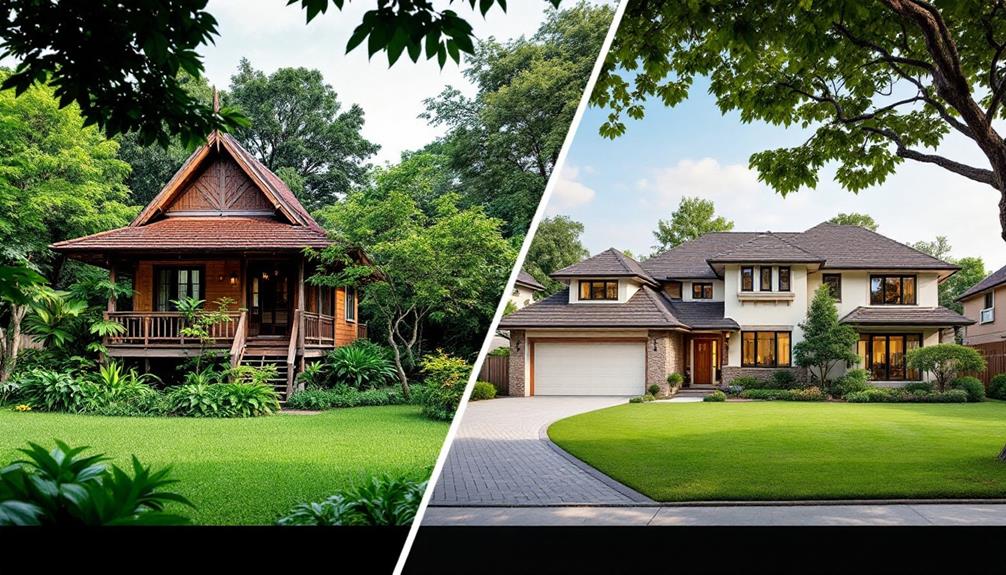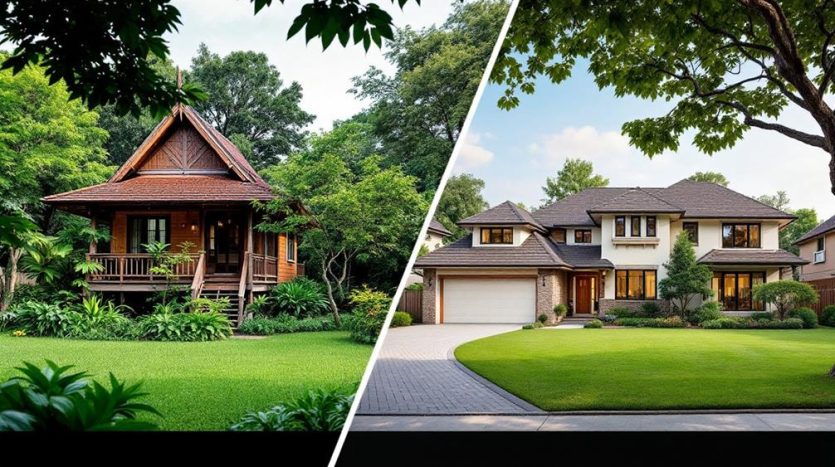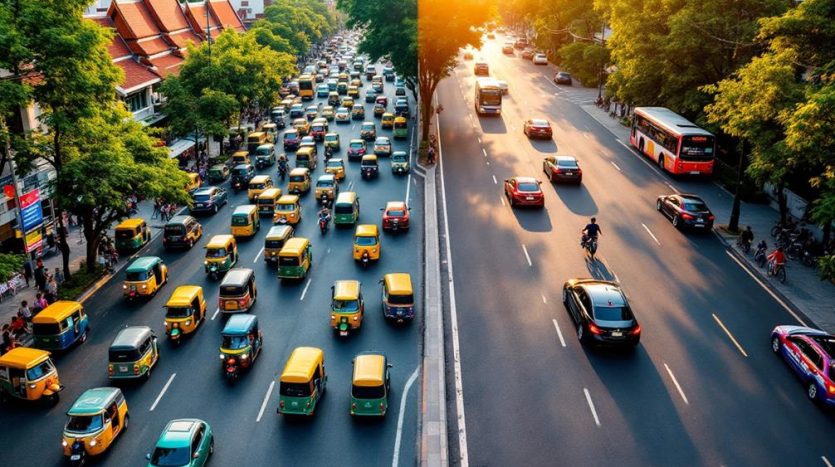Is It Cheaper to Live in Thailand or Us?
Imagine walking through a bustling Thai market, where the aroma of street food mingles with the vibrant colors of fresh produce, and your wallet feels surprisingly heavier. You're considering whether living in Thailand truly offers a more affordable lifestyle compared to the US. From housing to healthcare, the differences in cost can be striking. However, it's not just about the numbers; quality and convenience also play significant roles. As you weigh the pros and cons of each country's living expenses, you might start to question if a move to Thailand aligns with your financial and personal goals.
Key Takeaways
- Housing costs in Thailand are lower, especially in rural areas, compared to US cities.
- Transportation expenses in Thailand, including public transport and taxis, are significantly more affordable than in the US.
- Healthcare in Thailand is cheaper, with lower insurance premiums and medical service costs than in the US.
- Dining out and street food options are budget-friendly in Thailand, unlike the higher restaurant prices in the US.
- Utility and grocery bills are generally cheaper in Thailand, though US gas prices are lower.
Housing Costs Comparison

When comparing housing costs between Thailand and the US, you'll notice significant differences that could influence your decision on where to live.
Let's explore the housing market dynamics, where Thailand often boasts lower rental prices, particularly in rural areas. Urban houses in Bangkok can range from 10-20 million baht, but rural properties in Thailand cost between 1-3 million baht, offering larger plots at lower prices. If you're an urban dweller, Bangkok might surprise you with its affordable expat accommodations, especially when compared to cities like New York or San Francisco.
However, in Thailand, property ownership can be a sticky subject due to housing regulations that require foreigners to navigate complex lease agreements or joint ventures.
In the US, property taxes can feel like a second mortgage, whereas Thailand tends to keep these costs more palatable. Home maintenance costs in Thailand are generally lower, though you might find yourself grappling with tropical wear and tear.
Housing trends in both countries show a preference for urban living, but Thailand offers a wider range of options for those seeking a more rural escape.
Ultimately, deciding between urban vs rural living in either country boils down to your lifestyle preferences and budget.
Just remember, whether you're in Thailand or the US, reading the fine print on lease agreements is essential—unless you enjoy surprise costs!
Grocery and Food Expenses
Having addressed housing costs, let's now turn our attention to grocery and food expenses, which also play a significant role in your overall cost of living.
In Thailand, grocery shopping can feel like a treasure hunt with local markets offering affordable seasonal produce. You might find yourself bargaining for mangoes like a pro, while in the US, your grocery bill may have you questioning if your apples were hand-picked by angels.
Street food in Thailand isn't only delicious and budget-friendly but also a staple for residents, making it easy to manage your food expenses even when dining out.
Here's a breakdown of key elements:
- Food Quality and Safety: Thailand offers fresh and diverse options at local markets, yet food safety can be a concern. In contrast, US grocery stores boast rigorous standards, albeit at a higher price.
- Dining Culture and Restaurant Variety: Thailand's street food scene is legendary, offering delicious meals at a fraction of US restaurant costs. However, the US wins in diversity, serving everything from sushi to soul food.
- Price Fluctuations and Dietary Preferences: In both countries, grocery prices fluctuate. Thailand tends to be cheaper, but if your dietary preferences lean towards Western brands, expect to pay more.
Ultimately, both countries offer unique meal preparation experiences, but your wallet might prefer Thailand's flavorful frugality.
Transportation Costs

Steering through transportation costs offers a glimpse into the broader economic landscape of both Thailand and the US.
Let's buckle up and navigate these waters with a GPS set to savings. In Thailand, public transport options aren't only diverse but also considerably cheaper. For example, a monthly pass for Bangkok's BTS Skytrain costs around $40. Meanwhile, a similar pass in New York City could set you back by a whopping $132. That's over three times the cost! You could say the Big Apple is taking a big bite out of your wallet.
Additionally, consider the overall rental prices in each location, as living costs greatly influence transportation budgets.
Now, let's talk taxi fares. In Thailand, hailing a cab is a budget-friendly decision. The base fare in Bangkok is about $1, and you can travel a fair distance without your fare skyrocketing.
In contrast, the US taxi fares are more, shall we say, high-octane? In many cities, you're looking at a base fare of $3, with the meter ticking like it's on a caffeine high.
Healthcare Affordability
When considering healthcare affordability, you'll notice a stark difference in the cost of medical services between Thailand and the US.
Data indicates that Thailand offers more economical insurance coverage options, which can considerably reduce your out-of-pocket expenses.
In Thailand, tax residency is determined by the duration of stay, which may affect your tax obligations and overall costs, including healthcare.
Cost of Medical Services
Healthcare costs in Thailand are notably lower compared to the United States, which can greatly influence overall affordability for residents and expatriates alike.
It's no surprise that Thailand has become a hotspot for medical tourism, offering you affordable yet high-quality care. Whether you're getting a routine check-up or undergoing a major procedure, you won't need to sell a kidney to pay for it—unless that's the procedure you're there for.
Here are some key points to reflect on:
- Medical Tourism Benefits: Thailand's healthcare system provides quality services at a fraction of the cost of the US. Many hospitals boast international accreditations, so you can sip on a coconut smoothie while receiving world-class treatment.
- Preventive Care Options: You'll find that preventive care in Thailand isn't only emphasized but also cost-effective. Regular health screenings can be done without the financial dread often associated with such services in the US.
- Outpatient Services: In Thailand, outpatient services won't leave you with a second mortgage. From specialist consultations to minor surgeries, costs are markedly lower, making it easier to maintain your health without draining your bank account.
Insurance Coverage Options
Steering through insurance coverage options in Thailand versus the US reveals stark differences in healthcare affordability for residents. While the US offers a dazzling array of coverage types, it often feels like you're paying for the fireworks display with premium comparisons that can send your wallet into shock.
In contrast, Thai insurance policies typically present more manageable premiums, though they might lack some of the bells and whistles.
Policy options in the US can be as complex as a soap opera plot, with deductible structures that demand a PhD to decode. Thailand, on the other hand, usually provides simpler plans, though they mightn't cover every ailment under the sun.
The provider networks in the US are vast but come with a claims process that can feel like an Olympic event. Thailand's claims processes are generally more straightforward, albeit with fewer participating providers.
Coverage exclusions are a universal headache, but Thai policies often list them in a more straightforward manner than their American counterparts.
Out-of-Pocket Expenses
Analyzing healthcare costs further, it's evident that out-of-pocket expenses play a significant role in determining affordability between Thailand and the US. In Thailand, you might find yourself with lower daily expenses when visiting local markets for healthcare services. The currency exchange rate often works in your favor, boosting your savings potential.
Meanwhile, in the US, you might want to explore budgeting strategies as unexpected costs can throw a wrench in your financial planning.
Here's a fun, yet informative numeric breakdown on out-of-pocket healthcare spending:
- Average Spending: In Thailand, a visit to the doctor might set you back around $30, while in the US, it could easily exceed $200. That's a lot of street food you're missing out on!
- Cost-Cutting Tips: Embrace lifestyle choices that incorporate preventive healthcare. In Thailand, this might involve traditional massage, which is both soothing and affordable.
- Savings Potential: With lower out-of-pocket expenses, Thailand offers more room for financial planning. You could save more towards that dream vacation or, you know, a wildly extravagant elephant ride.
Utility Bills Overview

When evaluating utility bills in Thailand and the US, you'll find notable differences in cost and consumption patterns. Let's explore the numbers, shall we? Electricity rates in Thailand are generally lower, but prepare for the occasional seasonal variation in your bill when the air conditioning works overtime. Meanwhile, US residents often face higher rates, but hey, at least your lights will stay on during a monsoon.
Water bills in Thailand are nearly as invigorating as a cold drink on a hot day, while in the US, you might think you're paying for bottled water. Internet expenses are another story. Thailand offers reliable service with competitive rates, though not quite as fast as a cheetah on roller skates. The US might give you speed, but it'll cost you.
Here's a quick comparison table:
| Utility Service | Thailand Cost (USD) | US Cost (USD) |
|---|---|---|
| Electricity Rates | Low | High |
| Water Bills | Low | Moderate |
| Internet Expenses | Moderate | High |
| Gas Costs | Moderate | Low |
Waste disposal is efficient in both countries, though gas costs are cheaper in the US. Ultimately, service reliability is consistent across both regions, even if the prices aren't.
Education and Schooling Costs
While evaluating education and schooling costs between Thailand and the US, it's essential to take into account both public and private options.
In Thailand, public education boasts lower tuition fees, but you might need to navigate language barriers and cultural differences. The US, however, offers free public education, though the quality varies drastically—like a rollercoaster ride you didn't sign up for.
Private schooling in both countries can cost a small fortune, especially when you consider international schools in Thailand where tuition fees soar sky-high.
- Tuition Fees: In Thailand, international schools can cost between $5,000 and $20,000 per year. In the US, private schools often exceed $10,000 annually, not including those shocking student loans for higher education.
- Educational Quality: While both nations host prestigious institutions, the US generally offers more scholarship opportunities to offset costs.
- Teacher Salaries: The US tends to offer higher salaries, potentially attracting more qualified educators, but Thailand offers a unique cultural experience that can enrich education beyond numbers.
In both countries, choosing between public and private schooling involves weighing educational quality against your budget constraints—like picking between a gourmet meal or a fast-food binge.
Entertainment and Leisure Spending

When comparing entertainment and leisure spending in Thailand and the US, you'll find significant differences in costs.
Movie tickets in Thailand are generally cheaper, with an average price of $3-$5 compared to the US average of $9-$13.
Additionally, nightlife and dining out can also be more cost-effective in Thailand, often providing a wider variety of affordable options that cater to various budgets.
Cost of Movie Tickets
In comparing the cost of movie tickets between Thailand and the US, it's clear that pricing varies greatly, reflecting broader differences in entertainment and leisure spending between the two countries.
In Thailand, a ticket costs around $3 to $6 depending on the cinema and city, much cheaper than the US, where it ranges from $9 to $15. This price disparity means you can indulge in more movie genres without breaking the bank in Thailand. Fancy a rom-com marathon or a superhero showdown? You can do both and still have money left for popcorn.
Moreover, Thailand offers enticing ticket discounts, making moviegoing even more affordable. Seniors, students, and even some weekday showings can snag you a deal. In the US, discounts exist but are often less generous and more restrictive.
Here's a breakdown of cost factors:
- Pricing Variability: Thailand's tickets range from $3-$6; the US charges $9-$15.
- Movie Genres: You can explore more genres in Thailand due to lower costs.
- Ticket Discounts: Thailand frequently offers broader, more accessible discounts.
Nightlife and Dining Prices
Nightlife and dining costs reveal stark contrasts between Thailand and the US, providing insight into broader entertainment and leisure spending habits. In Thailand, you can immerse yourself in vibrant nightlife trends without burning a hole in your pocket. The bar scene is lively yet affordable, with a local beer costing around $2. Meanwhile, in the US, you might need to sell a kidney to afford a night out, with drinks averaging $6. Dining experiences also differ; Thailand's street food offers mouthwatering local cuisine for just a couple of bucks, whereas US food markets make you wonder if you're buying gold-plated hot dogs.
| Category | Thailand | US |
|---|---|---|
| Local Beer (Bar) | $2 | $6 |
| Street Food Meal | $2 | $10 |
| Luxury Restaurant Meal | $50 | $80 |
| Cultural Event Ticket | $15 | $50 |
Luxury restaurants in Thailand allow for indulgence without financial despair, unlike in the US where such dining experiences might require a second mortgage. Expat hangouts in Thailand offer a blend of local and international vibes at entertainment venues, while cultural events provide rich experiences at a fraction of US costs. So, if you fancy a lavish lifestyle without the hefty price tag, Thailand's nightlife and dining scene might just be your ideal match.
Dining Out Expenses
Although the dining out scene in both Thailand and the US offers diverse experiences, the cost differences are significant.
In Thailand, you'll find a treasure trove of local cuisine, with street food reigning supreme. It's where food safety meets a thrilling adventure, and where meal prices are so low, you'll consider adopting Pad Thai as a new food group.
In contrast, the US dining culture offers a wide restaurant variety, from burger joints to Michelin-starred fine dining—each with its own set of dining etiquette rules that could stump even the savviest diner.
Here's a quick breakdown:
- Street Food vs. Fine Dining: In Thailand, a hearty street food meal might cost as little as $1, while in the US, fine dining can easily set you back $50 or more per person.
- Local Cuisine: Thai food is generally cheaper, even in restaurants. A typical meal could cost around $3-$5, compared to $10-$15 in the US.
- Restaurant Variety: The US offers a broader range of cuisines but at a steeper price, whereas Thailand offers a consistent focus on affordable local flavors.
Clothing and Apparel Prices

When evaluating the cost of living between Thailand and the US, clothing and apparel prices reveal another stark contrast. In Thailand, local markets brim with budget-friendly options that cater to the frugal fashionista in you. If you love keeping up with fashion trends without breaking the bank, you're in luck. Thailand's textile pricing is generally lower, thanks to reduced import taxes and an abundance of local materials.
Brand availability varies, but don't expect to find that Gucci sweater for a steal. Instead, enjoy local brands offering quality comparison at a fraction of US prices. Your shopping habits might shift as you discover eco-friendly options in Thailand that are as kind to your wallet as they're to the planet.
Seasonal clothing is less of a concern in the tropics, so you can skip the winter wardrobe and invest in lightweight, breathable attire. Cultural influences are evident, as traditional Thai styles often weave into modern designs.
In contrast, the US market offers a vast array of options, but with higher costs influenced by import taxes and a focus on global brands. Ultimately, Thailand's apparel scene can save you money, assuming you don't pack an extra suitcase.
Insurance and Taxes
When comparing insurance and taxes between Thailand and the US, you'll find significant differences in health insurance costs and taxation structures.
Thailand often offers lower health insurance premiums, but you should consider the coverage levels and accessibility.
On the tax front, the US typically has higher income tax rates, whereas Thailand employs a more simplified and often lower tax system for residents.
Health Insurance Costs
Health insurance costs present a significant factor when comparing the cost of living between Thailand and the US. If you're considering the move, it's crucial to explore healthcare plans and premium comparisons before packing your bags.
In Thailand, private health insurance is generally more affordable, but don't let the low premiums fool you—it's not all sunshine and mangoes. Here's what you need to know:
- Premium Comparisons: In the US, the average annual premium for a single person can skyrocket to around $7,739. In Thailand, it's often under $1,000, depending on the coverage. That's a lot of extra pad thai you could be enjoying.
- Coverage Quality: US plans often offer extensive networks and coverage, but they come at a hefty cost. Thai healthcare plans may have limited networks but can still provide quality care, especially in urban areas.
- Access to Care: In Thailand, you might find shorter wait times and personalized service for routine care. Meanwhile, in the US, you're likely to experience the joy of endless paperwork and phone calls—an adventure in its own right.
Taxation Differences
As you weigh the cost of health insurance, it's also important to contemplate how taxation impacts your overall expenses in Thailand versus the US.
Tax residency plays an essential role in determining your tax obligations in each country. In Thailand, if you spend more than 180 days a year, congratulations—you're a tax resident! This means you benefit from tax incentives like lower income tax rates compared to Uncle Sam's hefty demands.
Now, let's talk expatriate taxation. If you're a US citizen, you can't just wave goodbye to taxes when you move abroad. The US taxes its citizens on worldwide income, so you might still owe Uncle Sam, unless you claim the Foreign Earned Income Exclusion.
Meanwhile, Thailand doesn't tax foreign income unless it's brought into the country—talk about a sweet deal for keeping your capital gains offshore!
Both countries have their quirks. The US might offer tax deductions, but Thailand's income tax rates can be as low as 0-35%, depending on your earnings.
Just don't forget to hire a savvy accountant to navigate these waters. After all, you wouldn't want to end up in a tax pickle!
Internet and Mobile Costs

Internet and mobile costs can greatly impact your overall cost of living, especially when comparing countries like Thailand and the US. If you're a digital nomad or just someone who can't live without being connected, you'll find these differences intriguing.
Let's break it down:
1. Internet Speed and Tech Infrastructure: In Thailand, you can enjoy high-speed internet at a fraction of the US cost. Their tech infrastructure supports impressive speeds, but don't be surprised if a gecko interrupts your Zoom call.
Meanwhile, the US offers reliable internet, albeit at a higher price, thanks to its robust tech infrastructure.
2. Mobile Plans and Data Usage: Thai mobile plans are generally cheaper, offering generous data packages. Whether you're streaming your favorite shows or doom-scrolling through social media, you won't break the bank.
In contrast, US mobile plans can feel like you're sponsoring a rocket launch with every gigabyte you consume.
3. Connectivity Options and Digital Access for Remote Work: Thailand provides various connectivity options that cater to remote workers, ensuring seamless digital access.
The US also excels in this arena but often with a higher price tag, because why not charge more for the "land of the free"?
Miscellaneous Living Expenses
When you plunge into miscellaneous living expenses, you'll find significant differences between Thailand and the US. In Thailand, local markets offer a treasure trove of affordable food sourcing options, making it a paradise for those with frugal shopping habits.
Meanwhile, the US might've you hunting for coupons like a modern-day Indiana Jones. Currency fluctuations play a pivotal role in your budget, so keep an eye on those ups and downs.
In terms of cultural experiences, Thailand presents inexpensive and vibrant choices. From street festivals to temple visits, your entertainment options are vast and wallet-friendly.
In the US, enjoying cultural experiences might mean shelling out more bucks, especially if your lifestyle preferences lean toward Broadway shows and gourmet coffee.
Joining expatriate communities in Thailand? You might find camaraderie and cost-sharing opportunities, while in the US, such communities often mirror the local cost structure.
Household supplies in Thailand can be sourced cheaply, especially if you embrace seasonal variations and shop smart.
However, in the US, a trip to the store might feel like preparing for an Olympic sport.
Ultimately, understanding these nuances will help you navigate the cost landscape, whether you're a bargain hunter or a splurge enthusiast.










